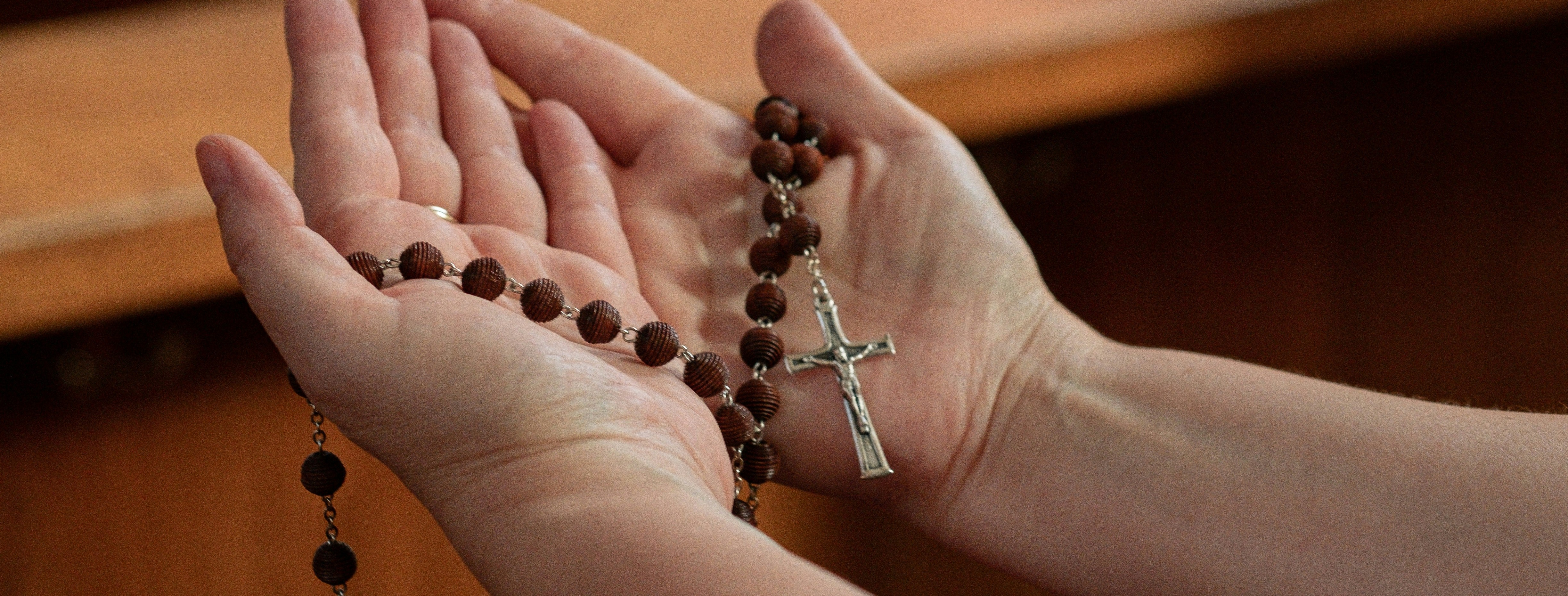The Rosary and Novenas
National Liturgical Council

The Rosary and Novenas are popular forms of devotion and can be both personal and communal forms of prayer.
The Rosary
The Rosary is both a form of prayer and a specific sacramental that aids in prayer which can be both a vocal and unspoken prayer.
The word "Rosary" comes from the Latin rosaries, which means “garland” or “bouquet of flowers” and the word bead is an Old English term that originally meant "a prayer." The use of beads as an aid in prayer has a long history and is used in many religions to provide a framework for prayer and the repetition provides a background for meditation.
The Rosary helps to keep in memory certain principal events or mysteries in the history of our salvation, and to thank and praise God for them.
The Rosary can be a tremendous aid in drawing closer to God. The structure and flow of the prayer of the Rosary is meant to aid the individual in meditation. The rhythm of the prayer can quiet the spirit and make a person more receptive to hearing God and thus being formed spiritually.
The grace of any sacramental is dependent on the attitude of the person using it. Since a group can recite the Rosary together, this form of prayer also has a communal aspect.
Saying the Rosary
The traditional Rosary has five sets of ten beads spaced closely together with a single bead spaced between. At the connecting point is a short string of a single bead, three beads and a single bead. A crucifix is at the head of this string.
Praying the Rosary involves recitation of common prayers while meditating on various events, called mysteries, associated with the life of Christ. There are twenty of these mysteries, divided into four sets of five: joyful, luminous, sorrowful and glorious.
The prayers used are those first prayers Catholic parents teach their children; the Creed (a statement of belief), the Our Father (a composition of adoration, contrition and petition), and the Hail Mary (which both pays honour to the Mother of God and asks for her intercession), and the Doxology (praise to the Trinity).
The Joyful Mysteries
- The Annunciation of the Lord
- The Visit of Mary to Elizabeth
- The Nativity of the Lord
- The Presentation of the Lord
- The Finding of Jesus in the Temple
The Sorrowful Mysteries
- Jesus in the Garden of Gethsemane
- Jesus is Scourged
- Jesus is Crowned with Thorns
- Jesus Carries his Cross
- Jesus Dies on the Cross
The Glorious Mysteries
- The Resurrection of the Lord
- The Ascension of the Lord
- The Descent of the Holy Spirit
- The Assumption of Mary into Heaven
- The Queenship of Mary
The Luminous Mysteries
- The Baptism of Jesus in the River Jordan
- The Wedding Feast at Cana
- The Proclamation of the Kingdom of God
- The Transfiguration of Jesus
- The Institution of the Eucharist
The Rosary focuses on key aspects of the Christian faith through the twenty mysteries. These meditations hold a wealth of truth and inspiration and lead to prayers of adoration, contrition, thanksgiving and petition.
As the Holy Spirit works in our hearts we are called to prayers of intercession such as world peace or the needs of a family member and in this way the Rosary is a very versatile form of prayer that can have new meaning each time it is prayed.
Novenas
A Novena, from the Latin word novem meaning nine, is nine days of private or public devotion to obtain special graces. Though they are not part of the liturgy, they remain a popular devotion since the beginning of the Church. Mary and the Apostles prayed from Christ’s Ascension to Pentecost, a period of nine days. (Acts 1)
In some Novenas, the same prayer is said each day for nine days, or sometimes nine times in one day; others may have different prayers for each of the nine prayer sessions. A Novena can extend over any nine days, as nine consecutive Mondays or nine first Fridays of the month.
Perpetual Novena
By extension the term is used for a regular series of prayers; eg., a Perpetual Novena occurring every Friday. Novenas are made especially in honor of the saints to ask their intercession for certain benefits.
In the middle ages, the Novena for Preparation, initially only Christmas followed later by Easter, is seen as the most fitting preparation for these feasts. The nine ‘O’ Antiphons are an example of a Christmas novena.
From the beginning of the nineteenth century various Novenas were enriched with indulgences in common for the whole church. There are thirty-two Novenas, intended for the most part for the preparation for definite feasts.
Through Novenas graces are given. Both the Rosary and the Novena lead us continually back to the celebration of the Liturgy and communion with the community.
This article was originally published in ‘Prayer and Devotions’. © Diocese of Parramatta. 2007. Reprinted with permission.
